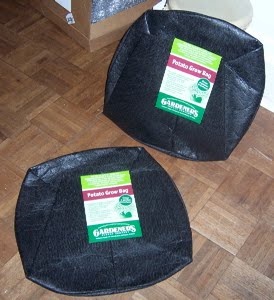She Gets It While She Can
How To Use A Potato Bin
 Potato bins and grow bags are used to grow the earliest potatoes. They are also used along with raised beds to grow prize winning potatoes for the garden show bench.
Potato bins and grow bags are used to grow the earliest potatoes. They are also used along with raised beds to grow prize winning potatoes for the garden show bench. Potato bins, bags, and potato barrels fit on any hard surface or small piece of ground open to full light. Try them on your patio or balcony. They give you a convenient way to harvest fresh spuds.
Here you'll discover how you can grow the earliest potatoes for summer salads and the latest 'new' potatoes to eat fresh and roasted for Christmas dinner.
They might be easy to grow.
POTATOES ARE EASY TO GROW VEGETABLES
I feel better already.
SELECTING POTATOES - make certain that you choose only certified seed potatoes for planting in the garden. Certification means the potatoes are free of insect or disease problems and that they have not been treated with a growth retardant. Garden centers; nurseries; garden outlets and hardware stores generally feature certified seed potatoes during the spring planting season.
SOIL PREPARATION - potatoes grow in just average soil, so a great deal of soil preparation is not really needed. However the addition of some compost or a little peat moss is beneficial. Avoid using fresh manure or lime in the soil where potatoes are to be grown, as it tends to cause scab on the potatoes. The addition of either 5-10-10 or 10-20-20 fertilizer is beneficial. Mix the fertilizer into the planting soil, prior to planting. Till or spade the soil to a depth of ten or twelve inches.
CUTTING POTATOES - if the seed potatoes are small to medium sized, plant the whole potato. If they are large sized, you can cut them in half, or quarter them. Each section should have two or three 'growth eyes'. After cutting, let the cut surface callus-over before planting them.
SPACING - potatoes can be grown in many different ways. If you have lots of room the cut pieces can be spaced about a foot apart in rows which are spaced two to three feet apart. Then cover with about an inch of soil. Pull in additional soil as the plants develop. Always be certain the surface tubers are covered with soil.
Hilling or mounding is another method of growing potatoes. Three or four pieces of potatoes are planted on a mound of soil, pulling in additional soil as the potatoes develop.
You can grow potatoes in the ground, in stacks of straw or mulch, in black plastic bags, in garbage cans or to stacks of tires. Potatoes can be a fun and easy crop to grow.
Field growing: This is the conventional way most potatoes are grown. Generally, the seed potatoes are planted about 12 inches apart in rows that are spaced 2 to 3 feet apart. The seed pieces' are planted about 1 inch deep, then covered with additional soil as the sprouts develop.
Straw: For centuries, Scandinavians have grown potatoes in stacks of straw or other mulching material. Potatoes are planted above ground in the straw, and as the vines begin to grow, additional straw` or mulch is mounded up around the base of the plants. This results in a yield of very clean potatoes. New potatoes can be harvested easily even before the potato vines mature completely.
Under plastic or in plastic garbage bags: Garden soil or a commercial potting soil can be used to grow the potatoes in the bags, Fold over the top half of the bag, fill with soil, and plant a certified seed potato that has been cut in half. The plastic bag can be set above ground wherever it's convenient. Punch holes in the bottom of the bag for drainage.
You also can plant potatoes under black plastic. Cut open a piece of the black plastic, and plant a potato piece. The potato tubers will develop as they would in the open ground. However, the tubers that develop close to the surface of the soil are shaded by the black plastic and should not develop the green inedible portions that often are found on other tubers. The black plastic also will aid in controlling weeds.
Garbage cans or containers: Old garbage cans, or wooden or fiberboard-type containers are suitable for growing potatoes, if they have adequate drainage. You can conserve space by growing them in this manner. A word of caution, though: The plants tend to dry out more rapidly when grown in containers, so additional watering will be needed. Otherwise, you're likely to end up with misshapen tubers.
WATERING - Black or hollow centers on potatoes is often caused by over-watering. Irregular watering causes irregular shaped or knobby potatoes. As a guideline, water potatoes (thoroughly) weekly during warmer summer weather.
HARVESTING - New young potatoes are harvested when peas are ripe or as the potato plants begin to flower. For storage of full sized potatoes harvest them when the vines turn yellow or have died-back.
STORAGE - Keep them in the dark, in a spot where temperatures are about 40 degrees.
I'm giving it a whirl. You might give it some thought.
Labels: compote something



0 Comments:
Post a Comment
<< Home